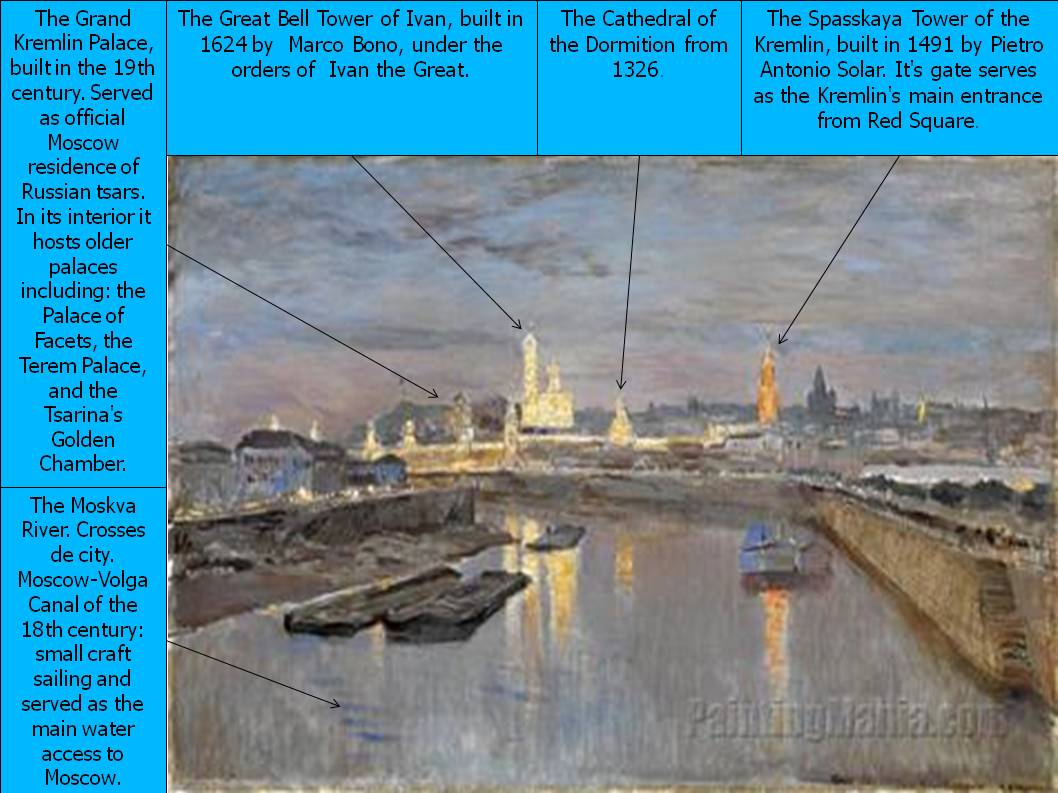MOSCOW (Isaac Levitan, 1896)
The Illumination of the Kremlin (1896), was painted by Isaac Ilich Levitan, a Russian painter fond of the beauty of the Volga region and its spirit. He narrated history through his painting, and that is why he captured the night of the celebration of Nicholas the Second coronation, reflecting the feelings that arose from the city, through its illumination. His style represents a bridge departing from realism towards impressionism. Through his art, he was able to reflect the characteristics which defined the Russian life.
The city of Moscow, capital of the Central Federal District of Russia, is the largest city in the country and one of the largest cities in the world. It’s located in the western part of the country and eastern from St. Petersburg. When it comes to topography, Russia has in its vast country, five different natural zones. Moscow is part of the European plain, or steppe zone. Most of the population is concentrated there due to the fact that it is one of the only habitable places for human life. Another important fact was that since the Industrial Revolution industries where located here, so that peasants moved towards the city looking for a job and hopefully for a better life. In the painting we can observe the Moskva River, which crosses the city of Moscow. It is a tributary to the Olka River which eventually flows into the Caspian Sea. It was and it is an extremely important resource for the city water supply. The Moskva River is hosted by the Moscow-Volga Canal, which at that period of time could only allow small craft sailing and served as the main water access to Moscow. Nowadays it serves as an important link for ships to travel to the north.
Although it is not visible from the painting point of view, the city has a radio centric morphology, imitating the shape of a spider web connecting the axis from the center to the outskirts. This urban layout begins at the Kremlin since it is the center of the city. This model was developed in the Middle Ages and it was centralized during the Renaissance. Since 1896-1897 to our modern time, the city has over gone tremendous changes, adapting poor neighborhoods (due to the great gap between rich and poor in Russia) into more modern, XX century ones.
The climate is a crucial factor to be taken into account, particularly when it comes to the materials used for construction. It is a continental humid climate that suffers exaggerated differences from summer to winter. These extreme conditions induced the use of materials such as stone and bricks in order to get more resistance against this brutal climate. It is important to mention that Moscow hosts an evolution of artistic movement, from Byzantine architecture, continuing with the Italian Renaissance movement, as well as some Baroque churches, and finally in Nicholas I regime, they adopted the Neoclassical for the construction of major building like the Great Kremlin Palace.
This painting was made to honor the coronation of Tsar Nicholas II, so it is logical that one of the most emphasized spots was the Kremlin, a fortified complex in the center of the city. That makes it the core location for a number of important buildings such as cathedrals, palaces, government buildings, etc. The Grand Kremlin Palace is one of the most significant buildings you can find in the Kremlin area, and it was built in the 19th century. It was the official residence of the Tsars and it included older palaces inside its perimeters with walls surrounding them.We can also see the Cathedral of the Dormition, a significant Christian temple considering that the Orthodox religion was imposed in Russia at that time. And as we have seen in many examples throughout history, religion provides power so it’s obvious that the Christian leader (an orthodox priest) lead the ceremony, making it an exceedingly devoted event.
The conservative Orthodox Christian church has been a strong influence since 988 in every aspect of the Russian lifestyle, including architecture, social and economical aspects. In the Tsarist Russia religious icons could be found decorating, not only religious temples such as cathedrals, churches, but even the palaces and private rooms of the Tsars were filled with them. As a result, the Tsars coronation took place in the Kremlin Palace, heart of Moscow. And it was after the coronation banquet that the illumination of Kremlin began. This celebration, plenty of fireworks, operas, etc, was intended for the masses, as to make it seem a festivity and a reason of celebration to give more importance to this date.
Another of the most outstanding buildings, represented with bright gold and white colors in the image, is the Great Bell Tower of Ivan. The reason why Levin made such a big deal about this building in his work was due to the strong symbolism it had for the Russian people, which was survival under pressure. It became even more significant after the failing attempt Napoleon had to destroy it. A very important factor concerning the Russian population in that century was that most of them was poor, mainly peasants who barely survived due to the constant raise of taxes and fees, thus making it impossible for poorer classes to gain any education which resulted in a 79% of the population being illiterate. In 1896-97 the population was 1,038,625, most of it working class born from the Industrial Revolution. It was because of this revolution that new ideological movements arose that would cause the fall of Tsar Nicholas II.
Sara Levy Martínez

